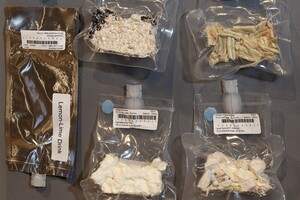
"We've become ashamed of making love to the food we eat," says Charles Michel. A young Franco-Colombian chef, Michel has bold ideas about the future of food. From chocolate mousse made with mashed up bees to innovative bowls and spoons that will make us eat more healthily, he's hacking food in remarkable ways.
A classically trained chef who spent his early years in France and Italy, including a stint at the three Michelin-starred Dal Pescatore in Canneto sull'Oglio, Michel has since split his time between Europe and Colombia, researching culinary innovation.
"Our brains evolved to like and perceive food via all the senses," he says. "By definition then, we can hack food visually, but it can also happen in all our senses." Recent food fads -- "the all-too-famous foams and spherifications"-- have given rise to a new culinary imagination and for Michel it is our perception of food, rather than its physical or molecular properties, that can have a huge impact on our tastebuds and waistlines.
He's currently working with the Crossmodal Research Laboratory -- a sensory research centre at Oxford University -- to conduct what he hopes will be the largest food perception experiment ever. The research, which anyone can take part in online, will look at how orientation in plating can change how much you enjoy a meal and how much you'd be willing to pay for it. But how food is arranged on the plate is just the start of the little-known science that shapes our diets.

Michel's Kandinsky-inspired salad Comes Cake
Every dish, Michel reckons, has an optimal orientation. He sees the experiment as a sort of crowd-sourced culinary design. Michel and a team of collaborators hope more than 50,000 people will take part. The experiment is part of Cravings, a new exhibition at the Science Museum in London that looks at how we are controlled by our food.
To put the theory to the test researchers at Crossmodal Lab arranged a salad to look like Kandinsky's Painting Number 201. When 60 people tasted three salads, all made of the same ingredients but arranged differently, they said the Kandinsky salad was the tastiest. Participants were also willing to pay twice as much for it. Eating from a gold spoon changes how viscous food feels in the mouth Science Museum
Eating from a gold spoon changes how viscous food feels in the mouth Science Museum
Working with designer and silversmith Andreas Fabian, who has a PhD in spoons, Michel is also designing experimental cutlery and plates that, by design, can target automatic behavioural responses. Such innovations could help people lose weight and eat more healthily without even realising it. When covered with gold leaf, for example, the perceived value and enjoyment of food could be heightened. How viscous food feels in the mouth can also be changed by eating from a golden spoon.
In an experiment conducted last year Michel found people were willing to pay substantially more when eating with better-quality, heavier cutlery, as opposed to cheap utensils. "Choosing the right cutlery can hack positively what you think about the food, even if you have no idea that the cutlery is the factor enhancing flavour and enjoyment."
Experimental spoons on show at the Science Museum's Cravings exhibition Science Museum
Michel explains that what we taste is often an illusion. Working with a team of researchers he's currently experimenting with fooling people into sensing a taste on their tongue when they are only actually tasting water. He calls this a "virtual taste illusion". "We have some preliminary data and still need more evidence, but we really believe that part of our everyday taste experience might be shaped by expectations and belief," he says. Essentially, we can be tricked into tasting something that isn't there.
"Apparently, without in-mouth tactility, there would not be much taste left, hence thinking about 'taste' alone might be narrowing down the topic too much," Michel argues, adding that our sense of smell is potentially more important than our tastebuds when determining how much we like our food.
 Researchers have found that eating from a bowl with a rounded bottom makes people feel full on less food /Science Museum
Researchers have found that eating from a bowl with a rounded bottom makes people feel full on less food /Science Museum
Even music can affect our enjoyment of food. How sweet, salty or sour something tastes can change depending on the background music, an effect known as "sonic seasoning". And food you literally can't put down could also influence how full we feel. Research conducted by the Crossmodal Lab in 2012 showed that eating from a bowl with a rounded bottom makes you feel full on less food.
But what about the future of food? Michel sees practical applications for his research in changing our everyday dietary habits.
"Research is starting to give insights on how to design more pleasurable experiences in order to orient consumptions of healthier stuff. What we need to do is to make healthier and sustainable foods to be more delicious, it's as simple as that," Michel says.
Our perception of taste is influenced by everything from how food looks to the music playing in the background/Alejandro Salgado
Entomological gastronomy could play a key role and Michel believes we should all be eating more insects. These "delicious, nutritious and sustainable protein sources" have already cropped up in restaurants in New York and London, but to many in the Western world chewing on grubs and larvae is still a disgusting prospect.
"One of the biggest challenges of this century is to reduce meat-consumption, because it's not sustainable. We have to do something, and we better do it quickly," Michel says. He's currently researching three aspects of insect food aesthetics -- making better arguments to persuade people to eat them, the way they are presented on the plate and the labels used to describe them. He's also been experimenting in the kitchen and described his chocolate mousse made from bees he breeds in his garden as "delicious".
His research into edible insects also has practical uses in deep space. Michel has been speaking to British astronaut Tim Peake about the challenges of eating well when in orbit. Not only is eating in microgravity messy, it also tastes very different. Space food tends to be bland because the amount of salt has to be substantially cut to stop sodium from damaging astronauts' bones.
Michel reckons a phenomenon known as 'perceptual constancy' could be used to provide astronauts with tastier meals. "If your first bite is saltier than the second, you don't realise that the second had less salt in it if you believe they're the same," he explains.
And in the future, with manned missions to Mars and beyond, space food will have to be even more innovative. "In a few decades ships will leave for long periods and the ship has to be completely isolated. Part of the food will probably have to be produced in the ship, using a closed recycling system." Space food tends to be bland as it has to be very low in sodium / Science Museum
Space food tends to be bland as it has to be very low in sodium / Science Museum
Or, to put it another way, astronauts could be eating bugs. Last year volunteers spent 105 days eating worms in a sealed laboratory in Beijing as part of a confined ecosystem of plants, worms and humans. Future space missions could rely on such systems. For his part, Peake says he'd be more than happy to chow down on worms in space.
But for the most part Michel has his feet firmly on the ground. The research being carried out by him and his colleagues at the Crossmodal Research Lab could have a big impact on how our diets. He believes people should see the kitchen as a laboratory, "a place where scientists, artists, philosophers and entrepreneurs can think and re-evolve the way we eat".
By ensuring big ideas about the future of food are available to everyone, Michel believes we can achieve meaningful change. But in the short-term, we can all make a start by getting in touch with our primal sensations and desires.
"The instincts that make us human, like eating from the same plate with people we love, licking the plate, sucking our fingers, slurping noisily -- all these acts can be done elegantly or, may I say, sensually. When did our animal instincts, the ones that make the basis of our humanity, became something vulgar?"
